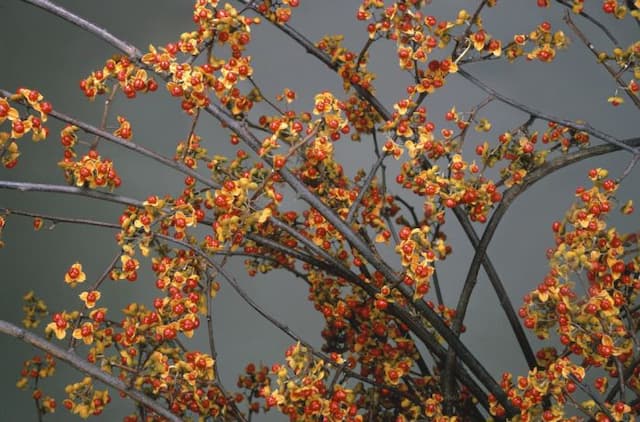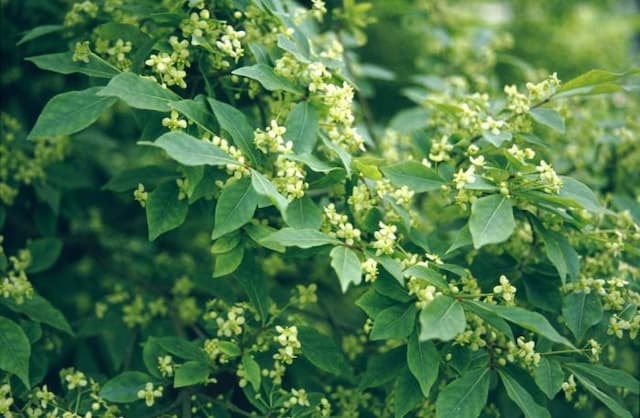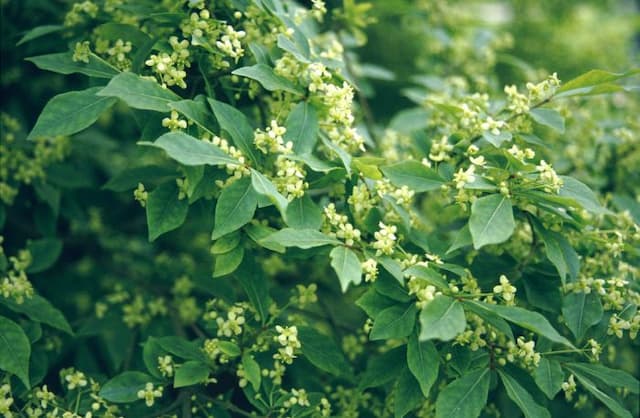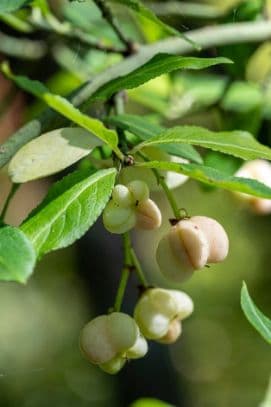Japanese Spindle Kathy Euonymus japonicus 'Kathy' (PBR)
ABOUT
Kathy, commonly known as Japanese Spindle, is a captivating evergreen shrub that boasts a dense, bushy habit. Its leaves are its most striking attribute, with each glossy, oval-shaped leaf displaying a variegated pattern that contrasts rich green with creamy white or pale yellow margins. These leaves are arranged in an opposite fashion along the stems, creating a lush and orderly appearance throughout the year. During the colder months, the variegated leaves take on a subtle pinkish hue, adding a touch of warmth to the garden landscape. In the spring or early summer, Kathy may produce inconspicuous greenish-white flowers. These small blooms are not the primary interest of this cultivar, as they often go unnoticed against the vibrant foliage. Instead, Kathy’s appeal lies in its foliage that provides visual interest in hedges, borders, or as a stand-alone specimen in a garden display. The plant is also well-suited for container planting, where its variegated leaves can be admired up close. Kathy is a cultivated variety, selected for its ornamental features and garden performance, making it a preferred choice for landscape designers and home gardeners alike.
About this plant
 Names
NamesSynonyms
Japanese Spindle, Evergreen Spindle, Japanese Euonymus.
Common names
Euonymus japonicus 'Kathy' (PBR).
 Toxicity
ToxicityTo humans
The plant commonly known as Japanese spindle can be toxic to humans. If ingested, parts of the plant can cause symptoms such as nausea, vomiting, diarrhea, weakness, and chills. More severe poisoning can lead to changes in heart rate and rhythm, convulsions, and in extreme cases, it can be fatal.
To pets
The Japanese spindle is also toxic to pets. If your pet consumes this plant, symptoms could include vomiting, diarrhea, abdominal pain, and weakness. In severe cases, ingestion could result in heart problems, muscle tremors, seizures, and potentially life-threatening complications. It is important to keep this plant out of reach of pets and to seek veterinary assistance immediately if you suspect your pet has ingested any part of it.
 Characteristics
CharacteristicsLife cycle
Perennials
Foliage type
Evergreen
Color of leaves
Variegated
Height
6 feet (1.83 meters)
Spread
5 feet (1.52 meters)
Plant type
Shrub
Hardiness zones
6
Native area
Japan
Benefits
 General Benefits
General Benefits- Ornamental Appeal: The plant features attractive variegated foliage, with creamy white edges and green centers, adding aesthetic value to gardens and landscapes.
- Low Maintenance: Euonymus japonicus 'Kathy' requires minimal care once established, making it suitable for busy gardeners or those with limited gardening time.
- Drought Tolerance: It is relatively drought-tolerant, which means it can survive periods of low water availability and is suitable for xeriscaping.
- Pest Resistance: This variety of Euonymus japonicus is generally resistant to pests, reducing the need for chemical treatments and maintenance.
- Hardiness: It is hardy in a range of climates and can tolerate a variety of soil types, making it versatile for different garden settings.
- Evergreen: As an evergreen plant, it provides year-round interest and structure in the garden, even during the winter months.
- Foundation Planting: Due to its growth habit and size, it is well-suited for use in foundation plantings to enhance the home’s curb appeal.
- Hedging and Topiary: The plant is well-suited for pruning and shaping, making it an excellent choice for formal hedges and topiary gardens.
- Versatile Usage: It can be planted in containers, used as a specimen plant, or incorporated into mixed borders, offering versatile options for garden design.
 Medical Properties
Medical PropertiesThis plant is not used for medical purposes.
 Air-purifying Qualities
Air-purifying QualitiesThis plant is not specifically known for air purifying qualities.
 Other Uses
Other Uses- Privacy Screens: Euonymus japonicus 'Kathy' can be closely planted to form dense hedges or privacy screens in gardens and along property boundaries.
- Topiary: With its easily shaped growth, this plant can be crafted into topiary forms for ornamental garden features.
- Erosion Control: Because of its robust root system, Euonymus japonicus 'Kathy' can be used on slopes or areas prone to erosion to help stabilize the soil.
- Seaside Gardens: It is tolerant of salt spray, making it suitable for coastal gardens.
- Urban Landscaping: The plant's pollution tolerance makes it ideal for urban settings where air quality might be compromised.
- Container Planting: This variety of Euonymus is well-suited for containers, which can add greenery to balconies, patios, or indoor spaces.
- Wildlife Garden: While not primarily a wildlife plant, it can offer shelter to small birds and insects.
- Themed Gardens: Its variegated foliage can contribute to color-themed garden designs such as white gardens.
- Foundation Planting: Its compact size and tolerance for pruning make it a good choice for planting along building foundations.
- Photography: The distinct variegation of the leaves provides a beautiful backdrop for garden photographers.
Interesting Facts
 Feng Shui
Feng ShuiThe Japanese spindle is not used in Feng Shui practice.
 Zodiac Sign Compitability
Zodiac Sign CompitabilityThe Japanese spindle is not used in astrology practice.
 Plant Symbolism
Plant Symbolism- Longevity: Euonymus plants like 'Kathy' are known for their resilience and hardiness, making them symbolic of longevity and endurance.
- Strength: They can withstand harsh conditions and hence represent strength and the ability to endure tough circumstances.
- Prosperity: In some traditions, the evergreen nature of Euonymus signifies continuous growth and is associated with prosperity.
- Protection: The dense foliage and often spiny branches are seen as protective features, making the plant a symbol of shelter and safety.
 Water
WaterJapanese Spindle 'Kathy' should be watered deeply when the top inch of soil feels dry to the touch, which typically equates to once every week during active growth periods in spring and summer. The amount of water should be sufficient to soak the root zone, about 1-2 gallons for young plants and up to 3-5 gallons for established shrubs. During the cooler months of fall and winter, reduce watering to every two to three weeks. Avoid overwatering, as this can lead to root rot. Make sure that the soil drains well to prevent water from standing around the root area.
 Light
LightJapanese Spindle 'Kathy' prefers a location that receives full sun to partial shade for optimal growth. The best spot would offer morning sunlight and some afternoon shade, particularly in hotter climates to prevent leaf scorch. Avoid deep shade as it may lead to sparse foliage and a lackluster appearance.
 Temperature
TemperatureThe Japanese Spindle 'Kathy' is well-suited for temperatures ranging from a minimum of 10°F to 15°F (-12°C to -9°C) and can survive short periods of colder weather. It thrives in moderate climates with temperatures between 50°F and 80°F (10°C to 27°C). To ensure optimal growth and health, avoid exposure to temperatures below 10°F, which may damage or kill the plant.
 Pruning
PruningPruning Japanese Spindle 'Kathy' is important to maintain its shape, remove damaged branches, and encourage new, healthy growth. Prune in late winter or early spring before the onset of new growth. Lightly trim to shape the plant and cut back any disproportionately long branches. Significant pruning should be done infrequently, only every 2 to 3 years, unless necessary to correct damage.
 Cleaning
CleaningAs needed
 Soil
SoilThe best soil mix for Japanese Spindle 'Kathy' should be well-draining, with a blend of loamy soil, peat, and perlite or sand. The soil pH should be slightly acidic to neutral, ranging from 6.0 to 7.5 for optimal growth.
 Repotting
RepottingJapanese Spindle 'Kathy' should be repotted every 2-3 years or when it becomes root-bound. Spring is the ideal time to repot to encourage new growth.
 Humidity & Misting
Humidity & MistingJapanese Spindle 'Kathy' prefers moderate humidity levels, around 40-50%. Avoid extremely dry air which can lead to leaf drop and damage.
 Suitable locations
Suitable locationsIndoor
Place in bright, indirect light and water when topsoil dries.
Outdoor
Full sun to part shade, sheltered from strong winds.
 Life cycle
Life cycleEuonymus japonicus 'Kathy', commonly known as Japanese spindle 'Kathy', begins its life cycle when a seed germinates, often in spring or early summer. The seedling grows and develops into a young plant, rapidly increasing in size and producing leaves. As the plant matures, it forms a bushy, evergreen shrub with variegated green and white leaves. When it reaches maturity, it produces small, inconspicuous greenish-white flowers, usually in the late spring or early summer, followed by pink to red fruits that contain seeds. After several years, as the plant ages, growth rate slows down, but it can continue to live and reproduce for many years if it is not subjected to harsh conditions or diseases. The cycle can start anew when the seeds from the fruits fall to the ground or are dispersed, find a suitable environment to grow, and germinate to produce new seedlings.
 Propogation
PropogationPropogation time
Spring-Summer
The Japanese spindle 'Kathy' is typically propagated through softwood cuttings. The most popular method involves taking cuttings from new growth in late spring to early summer. These cuttings should be about 4 to 6 inches long and have several sets of leaves. The bottom set of leaves is removed, and the cut end can be dipped into rooting hormone to enhance root development. The cutting should then be inserted into a well-draining potting mix, ensuring at least one set of leaves is above the soil surface. The pot should be placed in a warm, humid environment, out of direct sunlight, to encourage rooting. A plastic bag or a propagator can be used to maintain the moisture around the cutting..Roots usually develop within 4 to 8 weeks, after which the cuttings can be transplanted.





![Spindle [Blondy]](/_next/image?url=https%3A%2F%2Fplants-admin.emdemapps.com%2Fimages%2Fplants%2F%2Fimages%2F604b642f54add.png&w=640&q=75)


